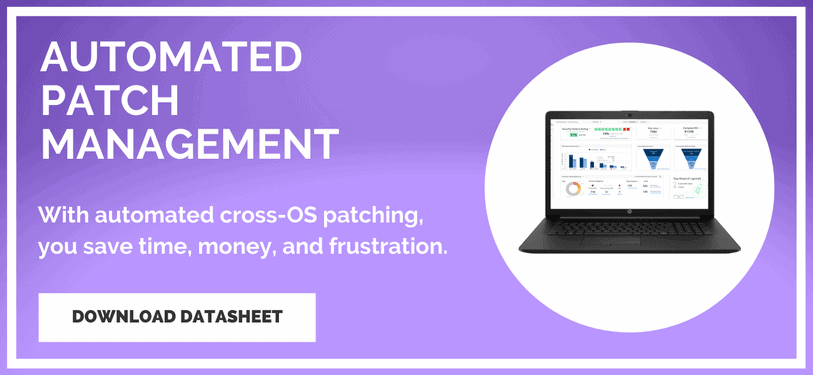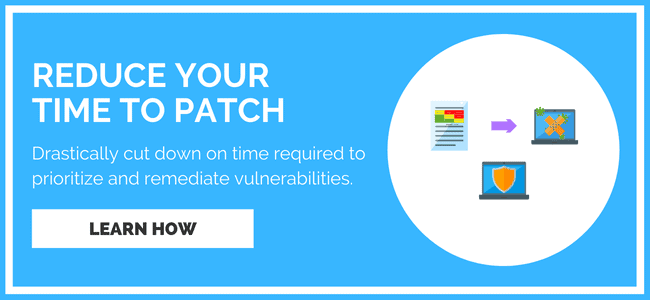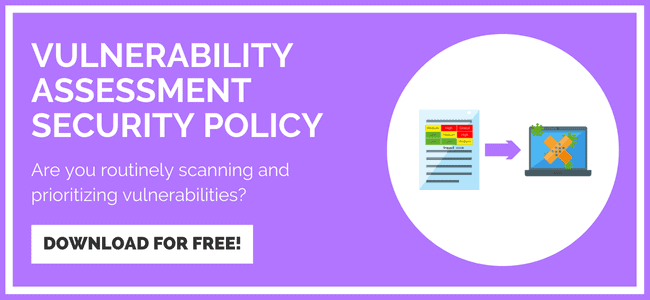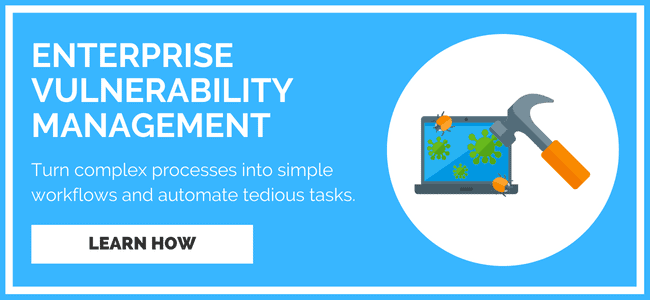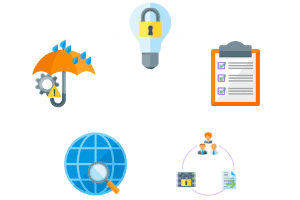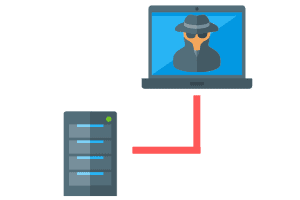Patch Management VS Vulnerability Management: Key Differences Explained
Learn about PurpleSec’s fully managed vulnerability management services.
Author: Eryk Waligora / Last Updated: 11/09/22
Reviewed By: Michael Swanagan, CISSP, CISA & Josh Allen
View Our: Editorial Process
Table Of Contents
The main difference between patch management and vulnerability management is that patch management is the operational process of applying remediations (patches) to vulnerable systems. Vulnerability management is the process of identifying, scanning and prioritizing vulnerabilities for remediation.
What You’ll Learn
- The main differences between patch and vulnerability management.
- Why organizations need a patch and vulnerability management program in 2023.
- Security policies you should have (along with free templates).
- Why PurpleSec is automating patch and vulnerability management
Many organizations manage vulnerabilities on a case-by-case approach meaning they only do the bare minimum required to ensure their networks and systems are protected.
This commonly includes performing scans once per year or quarter and providing some type of report.
This baseline approach may have been effective a decade ago but with the rise of the threat landscape, a more proactive solution is required to prevent the growing number of cyber-attacks worldwide. organizations must do more than the basic requirements.
Developing a more mature approach doesn’t necessarily mean a heavy lift, but a smarter lift. The most effective means of uplifting vulnerability management to meet these standards of protection must include patch management.
This holistic approach will enable any security program to face these threats impacting organizations today and in the future.
This article will dive into key concepts to explain the difference between patch management and vulnerability management, looking at how both are important on their own and how they are most effective when combined.
After reading this article you will be able to fully understand this security approach and how the introduction of automation into these processes is being used to increase return on security investment (ROSI).
What Is The Difference Between Vulnerability Management And Patch Management?
Vulnerability management and patch management are often (incorrectly) used interchangeably. The first thing to know is that patch management is a process within the broader scope of vulnerability management.
To gain a firmer understanding on these differences, we’ll need to define both.
- Vulnerability management is a management process designed to proactively identify, classify, remediate, and mitigate vulnerabilities in an IT infrastructure with the goal of reducing overall risk to an organization.
- Patch management is the management of actioning the removal of software vulnerabilities. This typically includes adhering to a patch management policy and operational process to include what to patch, a patching timeline, and levels of priority.
As you can see, you can have vulnerability management without patch management, but you can’t have patch management without vulnerability management. One is dependent on the other.
Patch Management Lifecycle
A process involving the necessary steps to action a patch. These steps are listed below:
- Develop an inventory of production systems such as IP addresses, OS, and applications.
- Organize all security controls.
- Use inventory and controls to compare to reported vulnerabilities.
- Mitigate the vulnerability by applying the patch.
- Document the patching and review.
Vulnerability Management Lifecycle
A broader approach to manage vulnerabilities, which includes the patch management life cycle. The steps taken in vulnerability management are:
- Assess vulnerabilities and their levels of risk to the organization.
- Prioritize patching (patching prioritization is not always from most severe to least reported vulnerability but prioritized as the most relevant impact to your organization).
- Patched the vulnerability.
- Review and assess patch.
- Improve the process by continuously monitoring and reporting on vulnerabilities.
Vulnerability Scanning
Vulnerability scanning involves a set of tools used to log into your systems via credentials or defaults providing a map of the entire system. During this process, the scan builds inventories then compares all the items listed against possible weaknesses.
Vulnerability Assessment
A vulnerability assessment is a process of identifying security vulnerabilities in systems, quantifying and analyzing them, and remediating those vulnerabilities based on predefined risks. Assessments are an essential part of a holistic security program and is cited by many industry standards and compliance regulations.
Remediation Planning
Vulnerability remediation is a process of eliminating detected weaknesses in your network. This process includes the discovery, prioritization, remediation, and monitoring of a vulnerability to ensure a successful long-term fix.
Change Management
The method of systematically implementing change both within internal and external processes is change management.
This type of management is important to vulnerability management because it defines the handling of a vulnerability and its impact to the greater security of the organization.
Having an understanding of these key concepts and tools provides a more holistic approach to building a mature and effective security program.
We’ll discuss more about the importance patch management and vulnerability management can bring to your organization.
Why Is Patch Management And Vulnerability Management Important?
Patch and vulnerability management are the bare minimum when developing a mature cyber security program.
They are often the first line of defense to remediate vulnerabilities. However, a more proactive approach is required to respond the growing volume and sophistication of cyber threats facing organizations in the world today.
Cybercrime is on the rise with more and more organizations falling victim to exposure and exploitation. Recent data breaches are more often than not a result of threat actors taking advantage of vulnerable systems.
This is having devastating effects on not only the security of an organization but impacting its bottom line typically resulting in thousands or millions in cost.
It is estimated that, worldwide, cybercrimes will cost $10.5 trillion annually by 2025.
A significant cause of these increased threats is due to the changing attack surface.
With the vast amount of Internet connected devices and systems used today, the opportunity for networks and applications to go unprotected has dramatically shot up.
As a result, organizations are more susceptible to attacks, with enterprises experiencing 130 security breaches per year, per organization, on average. Simply put, organizations are struggling to secure and keep up with the number of potential vulnerabilities out there.
Clearly, having a patch management and vulnerability management are important features for any security program today, and essentially a requirement!
So, where do you start in building a vulnerability management program?
We’ll look at how designing and implementing vulnerability and patch management policies are necessary to build and maintain a strong program.
Do I Need A Vulnerability And Patch Management Policy?
Having distinct policies for both patch management and vulnerability assessments are key elements for maturing your vulnerability management program.
These policies help lift a program off the ground, from development to operationalization, where the remediation of vulnerabilities can be properly actioned.
Keep in mind, when creating a vulnerability and/or patch management policy, you will almost certainly have to have buy-in and review not only from leadership within the general security program of your organization, but cross-functionally with other business units, such as, IT, legal, operations, and finance.
Crafting a policy on how the organization will manage its vulnerabilities can have an impact on how the rest of the organization may function.
Patch Management Policy
Security vulnerabilities are inherent in computing systems and applications.
These flaws allow the development and propagation of malicious software, which can disrupt normal business operations, in addition to placing your organization at risk.
In order to effectively mitigate this risk, software “patches” are made available to remove a given security vulnerability.
A patch management policy helps to ensure these patches are actioned, as well as sets up a process for testing, monitoring, and reporting for continuous improvements.
It’s important that a policy defines these features so that there is alignment on expectations and step-by-step tasks for accountability.
Vulnerability Assessment Policy
The purpose of a vulnerability assessment policy is to establish standards for periodic vulnerability assessments.
This policy will reflect your organization’s commitment to identify and implement security controls, which will keep risks to information system resources at reasonable and appropriate levels.
This type of policy is very common within security and vulnerability management programs.
It’s often the first type of security implemented, because vulnerability assessments create a baseline of the organization’s vulnerability landscape, which helps to inform and influence other security needs.
Why PurpleSec Is Automating Patch And Vulnerability Management
PurpleSec’s risk management platform is a solution to uplift an organizations’ security posture by leveraging the use of automation for continuous vulnerability management and improved patch management.
There are several key benefits to this approach.
First, automating vulnerability management reduces manual and repetitive tasks for security teams. Our tools automate prioritizing and patching based on risk and configure SLAs and timelines.
Based on this smart prioritization, detailed reports are then generated to provide a risk rating for your organization.
While reducing the manual and repetitive work, our approach also streamlines the process for vulnerability management by embedding our security experts with your teams to provide oversight and project management.
Combined with speedy and smart prioritization we leave it to human-managed approval for patches.
PurpleSec it also available as a consultant to make recommendations on improving overall systems and to answer important security questions such as:
- Is this something I should patch?
- What would be the impact on the organization if I did patch?
- What’s the likelihood of an attack?
Our approach will improve your organization’s return on security investment.
The expertise and technology leveraged by PurpleSec will always be a more cost-effective continuous solution for your security program, going beyond point-in-time assessments or scans.
Wrapping Up
Now that you understand the fundamental differences between patch management and vulnerability management and how the two can work in tandem, you can begin to operationalize a security posture with greater maturity and a launchpad toward proactive defense using automation.
Schedule a demo to learn more about the management approaches described in this article and to find out how PurpleSec Can be the solution to your security needs.

Eryk Waligora
Eryk has a multi-perspective experience from his over 10 years of professional work in the media/entertainment, technology, and cyber security industries. He is currently serving as a cyber threat intelligence manager as well as a technical writer for PurpleSec.
Recent Articles
Categories
Policy Templates
Most Popular

